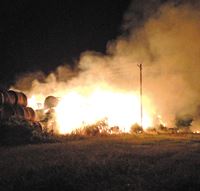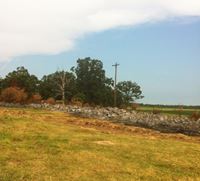|
Hay Fires Difficult To Extinguish, Bales Can Combust Spontaneously
HOPE, ARK.
Hay and fire are a bad combination for more reasons than you might think. During times when fire danger is high, dry grass and hay can be the starting point for wildfires.
Despite some rainfall, Arkansas is still dry. Drought still covered more than a third of the state, according to the U.S. Drought Monitor map released Thursday, with areas covered by extreme drought more than doubling over a week’s time. The wildfire danger in all of Arkansas was either moderate or high, according to the Arkansas Forestry Commission. Burn bans were on in dozens of counties.
In some cases, pastures and unbaled hay can be lost due to mower blades striking sparks on a rock. Once baled, hay on fire presents different difficulties.

Stacked round bales ablaze in this file photo taken in August 2013 in Miller County.
U of Arkansas System Division of Agriculture photo by Doug Petty

The aftermath of a fire in stacked round bales, taken Aug. 2013, in Miller County.
U of Arkansas System Division of Agriculture photo by Doug Petty
“There are several factors that make hay fires difficult to extinguish,” said Jon Barry, an extension forester for the University of Arkansas System Division of Agriculture, and a volunteer firefighter in southwestern Arkansas.
Once aflame, round bales are difficult to put out because of how they’re rolled and because of the grass that comprises it.
“Round hay bales in particular are pretty tightly compressed,” Barry said. “The hay baler assembles the bale in layers like a roll of paper.
“Because the hay is tightly compressed, a round bale doesn't burn intensely or quickly,” he said. “It is a smoldering fire that burns up into the bale. The bale has to be taken apart to get to the fire so it can be put out, and all of it has to be put out or it will flare up again.”
There are several approaches, depending on where the bale is and the terrain.
“Grass is a tough plant and that gives round hay bales a distinct tough grain pattern almost like wood grain,” he said. “When we are trying to get into the bale to find the smoldering area, we have to work across the grain, and that’s hard work.”
If the bale is out in a hay field, “the most effective approach is to get the farmer to tear the bale apart with his tractor,” he said. “If the terrain is flat, sometimes we just push the bale along and unroll it.”
“Since we are going to spray water all over and into the bale, it is a total loss to the farmer anyway so nothing is lost by tearing the bale apart,” Barry said.
Square bales aren’t as tightly compressed and tend to burn quickly, although stacked square bales can burn very intensely.
Another cause for hay fires is fermentation caused by hay that’s too moist.
For all hays, moisture monitoring is necessary to produce consistently high-quality hay and that moisture will stimulate the growth of microbes in the hay, causing heat, said Dirk Philipp, assistant professor for the University of Arkansas System Division of Agriculture.
“Even at recommended moisture levels, hay will slightly increase in temperature, as microbes respire for a couple of weeks and slightly increase bale temperature – up to around 120 degrees Fahrenheit,” he said.
If moisture is left unchecked, temperatures will rise.
If the hay is allowed to ferment with high moisture levels, “temperatures may reach 180 degrees or more and the hay may be in danger of spontaneous combustion,” Philipp said.∆
|
|